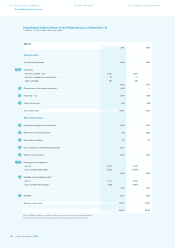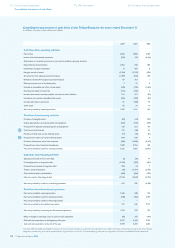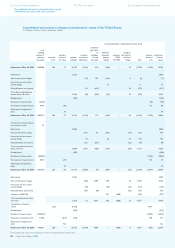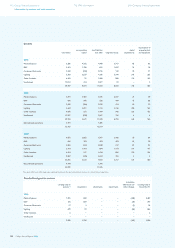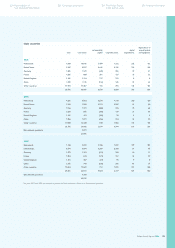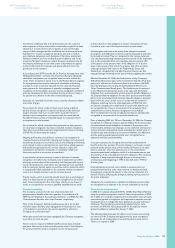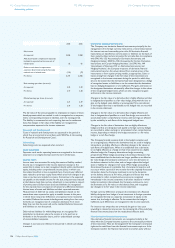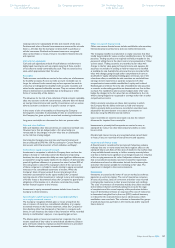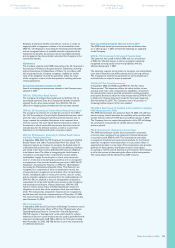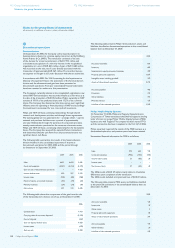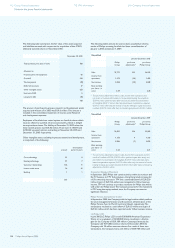Philips 2006 Annual Report Download - page 126
Download and view the complete annual report
Please find page 126 of the 2006 Philips annual report below. You can navigate through the pages in the report by either clicking on the pages listed below, or by using the keyword search tool below to find specific information within the annual report.
Philips Annual Report 2006126
2004 2005
Net income
As reported 2,836 2,868
Add: Stock-based compensation expenses
included in reported net income, net of
related taxes 52 65
Deduct: stock-based compensation
expenses determined using the fair-value
method, net of related taxes (115 ) (77 )
Pro forma 2,773 2,856
Basic earnings per share (in euros):
As reported 2.22 2.29
Pro forma 2.17 2.28
Diluted earnings per share (in euros):
As reported 2.21 2.29
Pro forma 2.16 2.28
The fair value of the amount payable to employees in respect of share-
based payments which are settled in cash is recognized as an expense,
with a corresponding increase in liabilities, over the vesting period.
The liability is remeasured at each reporting date and at settlement
date. Any changes in fair value of the liability are recognized as
compensation expense in the income statement.
Research and development
Costs of research and development are expensed in the period in
which they are incurred, in accordance with SFAS No. 2, ‘Accounting
for Research and Development Costs’.
Advertising
Advertising costs are expensed when incurred.
Lease payments
Payments made under operating leases are recognized in the income
statement on a straight-line basis over the term of the lease.
Income taxes
Income taxes are accounted for using the asset and liability method.
Income tax is recognized in the income statement except to the
extent that it relates to an item recognized directly within stockholders’
equity, including other comprehensive income (loss), in which case
the related tax effect is also recognized there. Current-year deferred
taxes related to prior-year equity items which arise from changes in tax
rates or tax laws are included in income. Current tax is the expected
tax payable on the taxable income for the year, using tax rates enacted
at the balance sheet date, and any adjustment to tax payable in respect
of previous years. Deferred tax assets and liabilities are recognized
for the expected tax consequences of temporary differences between
the tax bases of assets and liabilities and their reported amounts.
Measurement of deferred tax assets and liabilities is based on the
enacted tax rates expected to apply to taxable income in the years
in which those temporary differences are expected to be recovered
or settled. Deferred tax assets, including assets arising from loss carry-
forwards, are recognized net of a valuation allowance if it is more
likely than not that the asset will not be realized. Deferred tax assets
and liabilities are not discounted.
Deferred tax liabilities for withholding taxes are recognized for
subsidiaries in situations where the income is to be paid out as
dividends in the foreseeable future, and for undistributed earnings
of unconsolidated companies.
Changes in tax rates are refl ected in the period in which such change
is enacted.
Derivative fi nancial instruments
The Company uses derivative fi nancial instruments principally for the
management of its foreign currency risks and to a more limited extent
for interest rate and commodity price risks. All derivative fi nancial
instruments are classifi ed as current assets or liabilities on the basis of
their maturity dates and are accounted for at trade date. In compliance
with SFAS No. 133, ‘Accounting for Derivative Instruments and
Hedging Activities’, SFAS No. 138, ‘Accounting for Certain Derivative
Instruments and Certain Hedging Activities’, and SFAS No. 149
‘Amendment of Statement 133 on Derivative Instruments and
Hedging Activities’, the Company measures all derivative fi nancial
instruments based on fair values derived from market prices of the
instruments or from option pricing models, as appropriate. Gains or
losses arising from changes in the fair value of the instruments are
recognized in the income statement during the period in which they
arise to the extent that the derivatives have been designated as a hedge
of recognized assets or liabilities, or to the extent that the derivatives
have no hedging designation or are ineffective. The gains and losses on
the designated derivatives substantially offset the changes in the values
of the recognized hedged items, which are also recognized as gains
and losses in the income statement.
Changes in the fair value of a derivative that is highly effective and that
is designated and qualifi es as a fair value hedge, along with the loss or
gain on the hedged asset, liability or unrecognized fi rm commitment
of the hedged item that is attributable to the hedged risk, are recorded
in the income statement.
Changes in the fair value of a derivative that is highly effective and
that is designated and qualifi es as a cash fl ow hedge, are recorded in
accumulated other comprehensive income, until earnings are affected
by the variability in cash fl ows of the designated hedged item.
Changes in the fair value of derivatives that are highly effective as
hedges and that are designated and qualify as foreign currency hedges
are recorded in either earnings or accumulated other comprehensive
income, depending on whether the hedge transaction is a fair value
hedge or a cash fl ow hedge.
The Company formally assesses, both at the hedge’s inception and
on an ongoing basis, whether the derivatives that are used in hedging
transactions are highly effective in offsetting changes in fair values or
cash fl ows of hedged items. When it is established that a derivative
is not highly effective as a hedge or that it has ceased to be a highly
effective hedge, the Company discontinues hedge accounting
prospectively. When hedge accounting is discontinued because it has
been established that the derivative no longer qualifi es as an effective
fair value hedge, the Company continues to carry the derivative on
the balance sheet at its fair value, and no longer adjusts the hedged
asset or liability for changes in fair value. When hedge accounting is
discontinued because it is probable that a forecasted transaction will
not occur within a period of two months from the originally forecasted
transaction date, the Company continues to carry the derivative
on the balance sheet at its fair value, and gains and losses that were
accumulated in other comprehensive income are recognized
immediately in the income statement. In all other situations in which
hedge accounting is discontinued, the Company continues to carry
the derivative at its fair value on the balance sheet, and recognizes
any changes in its fair value in the income statement.
Foreign currency differences arising on the translation of a fi nancial
liability designated as a hedge of a net investment in foreign operation
are recognized directly as a separate component of equity, to the
extent that the hedge is effective. To the extent that the hedge is
ineffective, such differences are recognized in the income statement.
For interest rate swaps that are unwound, the gain or loss upon
unwinding is released to income over the remaining life of the underlying
fi nancial instruments, based on the recalculated effective yield.
Non-derivative fi nancial instruments
Non-derivative fi nancial instruments are recognized initially at fair
value when the Company becomes a party to the contractual provisions
of the instrument. They are derecognized if the Company’s contractual
rights to the cash fl ows from the fi nancial instruments expire or if the
Company transfers the fi nancial instrument to another party without
112 Group fi nancial statements
Accounting policies
172 IFRS information 218 Company fi nancial statements


